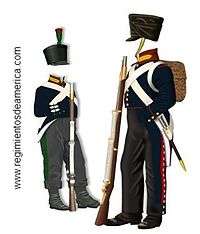Army of the Andes

The Army of the Andes (Spanish: Ejército de los Andes) was a military force created by the United Provinces of the Río de la Plata (Argentina) and mustered by general José de San Martín in his campaign to free Chile from the Spanish Empire. In 1817, it crossed the Andes Mountains from the Argentine province of Cuyo (his staging point being the current-day province of Mendoza, Argentina), and succeeded in its objective by dislodging the Spanish from the country.
The exact number of the army varies between different sources; some have put the number as low as 3500, while others have it being as high as 6000 men.[1] The army consisted of Argentines and Chileans, and included some 1200 auxiliaries to help in provisioning and supply, as well as a complement of artillery. The Congress of Tucumán endorsed San Martín's proposal to form an army to fight the royalists in Chile,[2] and between August 1814 and February 1817, San Martín trained his troops to prepare them for their ordeal.[3] While the army was made up of a less than experienced military force, San Martín intended to lead, with regular discipline and equipment, a proper army and not a "motley crew" into battle.[4]
For the crossing of the mountains, the Army was divided into two main columns, the first, commanded by Captain General[5] San Martín and supported by Brigadier Major[5] Miguel Estanislao Soler and Brigadier[5] Bernardo O'Higgins, would take the Los Patos Pass and the second, commanded by Colonel[5] Juan Gregorio de las Heras, would take the Uspallata Pass, which at its highest reaches some twelve thousand feet above sea level.[3] Because this second pass was more negotiable, the artillery was taken in the second column.
These two divisions were the main body of the Army, but there were smaller detachments sent to the north and south as flanking wings. The smaller division to the north was composed of some 130 infantry as well as a group of Chilean expatriates, and was under the command of Juan Manuel Cabot. To the south was a group under the command of the Chilean Ramón Freire Serrano.
After their 25-day journey across the Andes, the Army of the Andes successfully met royalist forces in the Battle of Chacabuco.[6] After the victory, they entered Santiago de Chile, where San Martin was unanimously elected Supreme Director but by his own resolve, as well as from instructions received from Buenos Aires, the general declined. After his refusal, O'Higgins was finally elected. Under Argentine officers, the Chilean army resurrected and San Martín was designated commander of the "United Army", which was an army that combined the forces of the Army of the Andes and Chilean troops. This new army fought the counterattack of royalist Army of Osorio at battles of Cancha Rayada and Maipú.
Composition of the Army of the Andes
Black soldiers

The number of black soldiers in the army of San Martin were numerous and grouped to form the majority of 7th, 8th and 11th Infantry Regiments. According to military doctrine of San Martin, colored soldiers would serve better in the infantry branch among the three arms of the army of the Andes. Blacks represented two thirds of soldiers of the Army of the Andes. They were estimated at between 2,000 and 3,000 Argentine freedmen who crossed the Andes to Chile in 1817 with San Martin. Black troops were mainly recruited from slaves which Lynch estimates a figure of 1,554 slaves. Most recruit in the provinces. Of those 2,500 black soldiers who began the crossing of the Andes, only 143 survived to be repatriated.
In all of these black regiments commissioned officers should be white under Argentine law. But San Martin sought to change the rules so that at least the black soldiers reached grades corporals and sergeants. But traditionally the Spanish colonial army battalions organized divided into castes of black slaves and free blacks, and San Martin believed even harder to gather people of color and whites fighting as soldiers in the same unit. Later both regiments 7 and 8 will be unified in Peru in the black regiment of the Río de la Plata.
Units 1814-1815
Argentine Units
- Horse Grenadiers Regiment
- Cavalry Militia Regiment
- San Juan Militias Regiment
- Mendoza Militias Brigade
- La Rioja Militias Brigade
- Commander in Chief's Own Mounted Rifles Escorts Squadron
- San Luis Volunteer Cavalry Regiment
- Mendoza Volunteer Cavalry Regiment
- Mendoza Volunteer Artillery Batteries
Chilean Units
- 1st Chilean Infantry Regiment
- Emigrant Battalion of Chilean Line Infantry
- Southern Patriotic Legion of Dragoons
- Chilean Battalion of Artillery
Combined Argentine-Chilean units
- Argentine Auxiliary Battalion
Units 1815-1817
- 3rd Battalion, Fatherland Regiment of Artillery
- 8th Infantry Battalion
- 11th Infantry Battalion
- 1st Battalion, Andes Rangers and Sharpshooters
- 7th Infantry Battalion
- Horse Grenadier Regiment
- Commander in Chief's Own Mounted Rifles Escort Squadron
- Rio de la Plata Black Regiment (raised 1816)
See also
Notes
- ↑ Crow, 1980, The Epic of Latin America, p. 466
- ↑ Crow, 1980, “The Epic of Latin America”, p. 465.
- 1 2 Robertson, 1922, History of the Latin-American Nations, p. 183.
- ↑ Chasteen, 2008, Americanos: Latin America’s Struggle for Independence, pp. 124
- 1 2 3 4 Official Military ranks granted by the government of the United Provinces of the Rio de la Plata
- ↑ Scheina, 2003, ”Latin America’s Wars: The Age of the Caudillo, 1791-1899”, p. 58.
References
- Chasteen, John (2008), Americanos: Latin America’s Struggle for Independence, Oxford University Press US, ISBN 0-19-517881-5
- Crow, John Armstrong (1980), The Epic of Latin America, University of California Press, ISBN 0-520-07723-7
- Robertson, William Spence (1922), History of the Latin-American Nations, D. Appleton and company
- Scheina, Robert (2003), Latin America’s Wars: The Age of the Caudillo, 1791-1899, Brassey’s, ISBN 1-57488-450-6